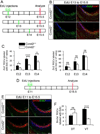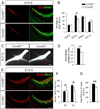The Ciliary Margin Zone of the Mammalian Retina Generates Retinal Ganglion Cells
- PMID: 28009286
- PMCID: PMC5234854
- DOI: 10.1016/j.celrep.2016.11.016
The Ciliary Margin Zone of the Mammalian Retina Generates Retinal Ganglion Cells
Abstract
The retina of lower vertebrates grows continuously by integrating new neurons generated from progenitors in the ciliary margin zone (CMZ). Whether the mammalian CMZ provides the neural retina with retinal cells is controversial. Live imaging of embryonic retina expressing eGFP in the CMZ shows that cells migrate laterally from the CMZ to the neural retina where differentiated retinal ganglion cells (RGCs) reside. Because Cyclin D2, a cell-cycle regulator, is enriched in ventral CMZ, we analyzed Cyclin D2-/- mice to test whether the CMZ is a source of retinal cells. Neurogenesis is diminished in Cyclin D2 mutants, leading to a reduction of RGCs in the ventral retina. In line with these findings, in the albino retina, the decreased production of ipsilateral RGCs is correlated with fewer Cyclin D2+ cells. Together, these results implicate the mammalian CMZ as a neurogenic site that produces RGCs and whose proper generation depends on Cyclin D2 activity.
Keywords: Cyclin D2; binocular vision; ciliary margin zone; contralateral RGCs; ipsilateral RGCs; neurogenesis; retina; retinal progenitors.
Copyright © 2016 The Authors. Published by Elsevier Inc. All rights reserved.
Figures







Similar articles
-
Neurogenesis and Specification of Retinal Ganglion Cells.Int J Mol Sci. 2020 Jan 10;21(2):451. doi: 10.3390/ijms21020451. Int J Mol Sci. 2020. PMID: 31936811 Free PMC article. Review.
-
CyclinD2-mediated regulation of neurogenic output from the retinal ciliary margin is perturbed in albinism.Neuron. 2023 Jan 4;111(1):49-64.e5. doi: 10.1016/j.neuron.2022.10.025. Epub 2022 Nov 8. Neuron. 2023. PMID: 36351424 Free PMC article.
-
Distinct timing of neurogenesis of ipsilateral and contralateral retinal ganglion cells.J Comp Neurol. 2019 Jan 1;527(1):212-224. doi: 10.1002/cne.24467. Epub 2018 Aug 22. J Comp Neurol. 2019. PMID: 29761490 Free PMC article.
-
Msx1-Positive Progenitors in the Retinal Ciliary Margin Give Rise to Both Neural and Non-neural Progenies in Mammals.Dev Cell. 2017 Jan 23;40(2):137-150. doi: 10.1016/j.devcel.2016.11.020. Epub 2016 Dec 20. Dev Cell. 2017. PMID: 28011038
-
Retinal Stem Cell 'Retirement Plans': Growth, Regulation and Species Adaptations in the Retinal Ciliary Marginal Zone.Int J Mol Sci. 2021 Jun 18;22(12):6528. doi: 10.3390/ijms22126528. Int J Mol Sci. 2021. PMID: 34207050 Free PMC article. Review.
Cited by
-
Tissue stretching is a confounding factor for the evaluation of neurodegeneration in the fast-ageing killifish.Biogerontology. 2023 Jun;24(3):403-419. doi: 10.1007/s10522-023-10026-1. Epub 2023 Mar 13. Biogerontology. 2023. PMID: 36913007
-
Neurogenesis and Specification of Retinal Ganglion Cells.Int J Mol Sci. 2020 Jan 10;21(2):451. doi: 10.3390/ijms21020451. Int J Mol Sci. 2020. PMID: 31936811 Free PMC article. Review.
-
Cell fate decisions, transcription factors and signaling during early retinal development.Prog Retin Eye Res. 2022 Nov;91:101093. doi: 10.1016/j.preteyeres.2022.101093. Epub 2022 Jul 8. Prog Retin Eye Res. 2022. PMID: 35817658 Free PMC article. Review.
-
CyclinD2-mediated regulation of neurogenic output from the retinal ciliary margin is perturbed in albinism.Neuron. 2023 Jan 4;111(1):49-64.e5. doi: 10.1016/j.neuron.2022.10.025. Epub 2022 Nov 8. Neuron. 2023. PMID: 36351424 Free PMC article.
-
Transcriptional Control of Axon Guidance at Midline Structures.Front Cell Dev Biol. 2022 Feb 21;10:840005. doi: 10.3389/fcell.2022.840005. eCollection 2022. Front Cell Dev Biol. 2022. PMID: 35265625 Free PMC article. Review.
References
-
- Ahmad I, Tang L, Pham H. Identification of neural progenitors in the adult mammalian eye. Biochem Biophys Res Commun. 2000;270:517–521. - PubMed
-
- Amato MA, Arnault E, Perron M. Retinal stem cells in vertebrates: parallels and divergences. Int J Dev Biol. 2004;48:993–1001. - PubMed
-
- Coles BL, Horsford DJ, Mcinnes RR, Van Der Kooy D. Loss of retinal progenitor cells leads to an increase in the retinal stem cell population in vivo. Eur J Neurosci. 2006;23:75–82. - PubMed
-
- Drager UC. Birth dates of retinal ganglion cells giving rise to the crossed and uncrossed optic projections in the mouse. Proc R Soc Lond B Biol Sci. 1985;224:57–77. - PubMed
Publication types
MeSH terms
Substances
Grants and funding
LinkOut - more resources
Full Text Sources
Other Literature Sources
Molecular Biology Databases

